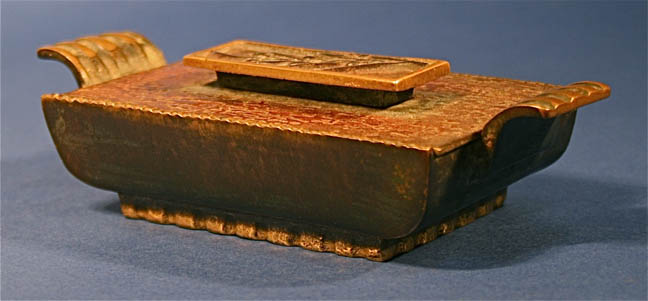

Title: Antique Art Deco Bronze Ashtray Incense Burner Display Box
Shipping: $29.00
Artist: N/A
Period: 20th Century
History: N/A
Origin: N/A
Condition: Excellent
Item Date: 1920 to 1930
Item ID: 4432
A remarkable small antique brown bronze incense burner display lidded box with all kinds of great design. The box has finely detailed art deco patterns. Inscribed in elegant designs that run around the exterior of this box cup. Its function as a vessel was for, incense burning. This is a fantastic bronze incense art deco architectural facade box. The top of the box comes off so that the incense can be placed inside, so it will allow the aroma to escape around the room. We have a selection of incense burners. Incense burners improve with age, and these old items are very rare. They are commonly used in religious ceremonies, and many of them are considered quite valuable.
Link: http://en.wikipedia.org/wiki/Incense
Incense (Latin: incendere, "to burn")is composed of aromatic biotic materials, which release fragrant smoke when burned. The term "incense" refers to the substance itself, rather than to the odor that it produces. It is used in religious ceremonies, ritual purification, aromatherapy, meditation, for creating a mood, and for masking bad odours.The use of incense may have originated in Ancient Egypt, where the gum resins and oleo gum resins of aromatic trees were imported from the Arabian and Somali coasts to be used in religious ceremonies.
Incense is composed of aromatic plant materials, often combined with essential oils. The forms taken by incense differ with the underlying culture, and have changed with advances in technology and increasing diversity in the reasons for burning it. Incense can generally be separated into two main types: "indirect-burning" and "direct-burning." Indirect-burning incense (or "non-combustible incense") is not capable of burning on its own, and requires a separate heat source. Direct-burning incense (or "combustible incense") is lit directly by a flame and then fanned or blown out, leaving a glowing ember that smoulders and releases fragrance. Direct-burning incense comes in several forms, including incense sticks (or "joss sticks"), cones, and pyramids.
The use of incense dates back to ancient times and may have originated in Sumerian and Babylonian cultures, where the gum - resins of aromatic trees were imported from the Arabian and Somali coasts to be used in religious ceremonies. It was also used by the Pharaohs, not only to counteract unpleasant odours, but also to drive away demons and gratify the presence of the gods.[
The Babylonians used incense while offering prayers to divining oracles. The Indus Civilization used incense burners. Evidence suggests oils were used mainly for their aroma. Incense spread from there to Greece and Rome. Brought to Japan in the 6th century by Korean Buddhist monks, who used the mystical aromas in their purification rites, the delicate scents of Koh (high-quality Japanese incense) became a source of amusement and entertainment with nobles in the Imperial Court during the Heian Era 200 years later.
During the 14th century Shogunate, samurai warriors would perfume their helmets and armor with incense to achieve an aura of invincibility. It wasn't until the Muromachi Era during the 15th and 16th century that incense appreciation (Kōdō) spread to the upper and middle classes of Japanese society.